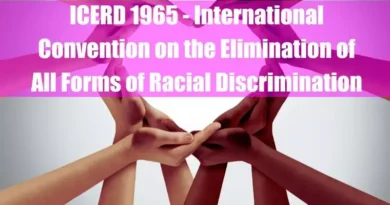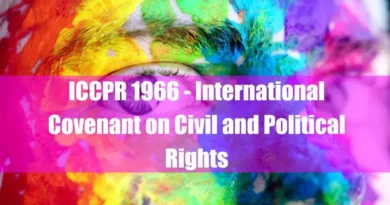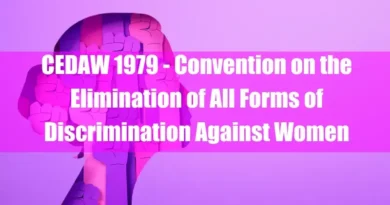Here are the key Takeaways from the article:
| Key Takeaway | Description |
|---|---|
| Universal Human Rights | The VDPA 1993 reaffirms that all human rights are universal, indivisible, and interdependent, ensuring that civil, political, economic, social, and cultural rights are equally important and must be protected and promoted together. |
| Establishment of OHCHR | The creation of the Office of the United Nations High Commissioner for Human Rights (OHCHR) in December 1993 provided a dedicated body within the UN to strengthen human rights promotion and protection globally, offering technical assistance and monitoring human rights situations. |
| Rights of Vulnerable Groups | The VDPA 1993 places significant emphasis on the protection of vulnerable groups, including women, children, indigenous peoples, and persons with disabilities, advocating for the elimination of discrimination and the promotion of their rights in all aspects of society. |
| Influence on International Law | The VDPA 1993 has profoundly impacted international human rights law by reinforcing the principles of universality, indivisibility, and interdependence and has contributed to the development of new human rights standards and instruments, such as the Convention on the Rights of Persons with Disabilities. |
| National Implementation | Following the VDPA 1993, many countries adopted national human rights action plans, strengthened legal frameworks to align with international standards, and established or enhanced national human rights institutions to ensure effective domestic implementation. |
| Successes and Challenges | Notable successes include establishing the UPR process and addressing issues like gender-based violence and children’s rights. Challenges such as political resistance, resource constraints, and the need to address emerging issues like digital rights and climate change impacts remain. |
| Criticisms | The VDPA 1993 has faced criticism for lacking enforceable mechanisms to ensure compliance and for not adequately addressing economic and social rights compared to civil and political rights. There are also concerns about the genuine commitment of some governments to the principles of the VDPA. |
| Legacy and Future Prospects | The VDPA 1993 continues to guide contemporary human rights issues and informs future initiatives, emphasizing the need for a holistic approach, international cooperation, and strong institutions to address ongoing and emerging human rights challenges. |
Let’s discuss in detail:
Part 1: Introduction to VDPA 1993
The Vienna Declaration and Programme of Action (VDPA) 1993 is a milestone for the global human rights movement. Adopted by consensus at the World Conference on Human Rights in Vienna, Austria, from June 14 to 25, 1993, it reaffirmed the international community’s commitment to human rights principles.
The VDPA consolidated various human rights initiatives into a unified framework, aiming to strengthen the protection and promotion of human rights worldwide.
Part 2: Historical Context and Background

What historical events led to the creation of the VDPA in 1993?
The VDPA 1993 emerged from a period of significant global change. The end of the Cold War in the early 1990s brought a new geopolitical landscape characterized by the dissolution of the Soviet Union and the democratization of Eastern Europe.
This shift allowed for a renewed focus on human rights as a universal concern, uniting former adversaries in a common cause. The atrocities witnessed during the Rwandan Genocide and the conflicts in the former Yugoslavia underscored the urgent need for robust international human rights mechanisms.
Who were the key figures and organizations involved in drafting the VDPA 1993?
The drafting of the VDPA 1993 was a collaborative effort involving numerous stakeholders. Representatives from UN member states, human rights organizations, and activists played crucial roles.
Mary Robinson, who later became the UN High Commissioner for Human Rights, was among the prominent figures advocating for a strong human rights framework. NGOs such as Amnesty International, Human Rights Watch, and the International Federation for Human Rights (FIDH) provided significant input, ensuring the declaration addressed a broad spectrum of human rights issues.
How did previous human rights declarations influence the VDPA 1993?
Previous human rights declarations and treaties significantly shaped the VDPA 1993. The Universal Declaration of Human Rights (UDHR) of 1948 laid the foundational principles of human rights that the VDPA sought to reaffirm and expand upon.
The International Covenant on Civil and Political Rights (ICCPR) and the International Covenant on Economic, Social, and Cultural Rights (ICESCR), both adopted in 1966, provided a comprehensive framework for civil, political, economic, social, and cultural rights. These documents, along with treaties like the Convention on the Elimination of All Forms of Discrimination Against Women (CEDAW) and the Convention on the Rights of the Child (CRC), influenced the content and principles of the VDPA 1993.
Part 3: Structure and Content of the VDPA
What are the main sections of the VDPA 1993?
The VDPA 1993 is divided into two main parts: the Vienna Declaration and the Programme of Action. Each part contains several sections that outline specific commitments, principles, and recommendations for promoting and protecting human rights.
How is the Vienna Declaration organized?
The Vienna Declaration is organized into preambular and operative sections. The preambular section sets the context, reaffirming the international community’s commitment to human rights principles. It acknowledges the progress made in human rights while recognizing the remaining challenges.
The operative sections address various human rights issues, outlining specific commitments and principles, such as the universality and indivisibility of human rights, the need to combat racism and discrimination, and the protection of vulnerable groups.
What key principles are outlined in the Vienna Declaration?
The Vienna Declaration outlines several key principles that form the foundation of the VDPA 1993:
- Universality and Indivisibility: It reaffirms that all human rights are universal, indivisible, and interdependent. Civil, political, economic, social, and cultural rights are equally important and must be protected together.
- Equality and Non-Discrimination: It emphasizes equality and non-discrimination, stating that all human beings are born free and equal in dignity and rights. It calls for the elimination of all forms of discrimination, including those based on race, gender, religion, and other grounds.
- International Cooperation: It highlights the importance of international cooperation in promoting and protecting human rights. States are urged to work together and support each other in fulfilling their human rights obligations.
- National Responsibility: While emphasizing international cooperation, the declaration underscores the primary responsibility of states to protect and promote human rights within their territories.
What is the structure of the Programme of Action?
The Programme of Action is structured around specific thematic areas and issues. It provides detailed recommendations and action points for states, international organizations, and civil society to implement the principles outlined in the Vienna Declaration. The Programme of Action covers a wide range of topics, including strengthening UN human rights mechanisms, promoting human rights education and training, enhancing the protection of vulnerable groups, combating racism, addressing the rights of indigenous peoples and minorities, promoting the right to development, and ensuring effective remedies for human rights violations.
Part 4: Key Provisions and Principles

What are the core human rights reaffirmed by the VDPA 1993?
The VDPA 1993 reaffirms a broad range of core human rights, encompassing civil, political, economic, social, and cultural rights.
These include the right to life, liberty, and security of person; freedom from torture and inhumane treatment; freedom of expression and association; the right to work and education; and the right to an adequate standard of living. By reiterating these rights, the VDPA underscores their universality and the necessity for comprehensive protection.
How does the VDPA 1993 address the issue of universality of human rights?
The VDPA 1993 addresses the issue of universality by affirming that all human rights are universal, indivisible, and interdependent. It rejects the notion that cultural or regional differences can justify the denial of human rights.
The declaration emphasizes that all states must promote and protect all human rights, regardless of their political, economic, or cultural systems. This principle of universality is a cornerstone of the VDPA, ensuring that human rights apply to all individuals without exception.
What provisions are made for protecting vulnerable groups in the VDPA 1993?
The VDPA 1993 places significant emphasis on the protection of vulnerable groups, including women, children, indigenous peoples, and persons with disabilities. It recognizes that these groups often face specific challenges and discrimination that require targeted measures.
The declaration calls for the elimination of gender-based violence and discrimination, the protection of children’s rights, and the promotion of the rights of indigenous peoples and minorities. It also advocates for the inclusion of persons with disabilities in all aspects of society and the removal of barriers to their full participation.
How does the VDPA 1993 promote the right to development?
The VDPA 1993 promotes the right to development as a universal and inalienable right. It acknowledges that development, democracy, and respect for human rights are interdependent and mutually reinforcing.
The declaration calls for the creation of conditions conducive to the realization of the right to development, including the establishment of fair international economic relations, the eradication of poverty, and the promotion of sustainable development.
By emphasizing the right to development, the VDPA highlights the importance of addressing economic and social inequalities as part of the broader human rights agenda.
What mechanisms does the VDPA 1993 propose for monitoring and implementation?
To ensure effective monitoring and implementation, the VDPA 1993 proposes several mechanisms. One of the key mechanisms is establishing the Office of the United Nations High Commissioner for Human Rights (OHCHR).
The OHCHR is tasked with promoting and protecting human rights globally, providing technical assistance to states, and monitoring human rights situations. The VDPA also calls for strengthening national human rights institutions and legal frameworks. It encourages states to establish independent human rights bodies, adopt comprehensive legislation, and create mechanisms to redress violations. Furthermore, the VDPA emphasizes the importance of international cooperation and support. It calls on states to cooperate with international human rights mechanisms, such as treaty bodies and special procedures, and to engage in constructive dialogue and mutual assistance.
Part 5: Impact and Implementation
What immediate actions were taken following the adoption of the VDPA in 1993?
Following adoption of the VDPA in 1993, several immediate actions were taken to implement its provisions and principles. Establishing the Office of the United Nations High Commissioner for Human Rights (OHCHR) in December 1993 was a significant step.
The OHCHR was created to enhance the United Nations’ global capacity to promote and protect human rights. Additionally, the VDPA prompted the international community to mainstream human rights into the work of all UN agencies and programs, integrating human rights considerations into various development initiatives and peacekeeping operations.
Countries were encouraged to adopt national human rights action plans and to establish or strengthen national human rights institutions to ensure effective implementation at the domestic level.
How has the VDPA 1993 influenced international human rights law?
The VDPA 1993 has had a profound impact on international human rights law. It reinforced the principles of universality, indivisibility, and interdependence of human rights, which have become fundamental tenets of international human rights law.
The declaration’s emphasis on the universality of human rights has been particularly influential in challenging cultural relativism and asserting that human rights apply to all individuals, regardless of their cultural, political, or social context.
The VDPA also contributed to developing new human rights standards and instruments. For example, the declaration’s focus on the rights of vulnerable groups helped pave the way for adopting the Convention on the Rights of Persons with Disabilities in 2006.
The VDPA’s call for the elimination of gender-based violence and discrimination influenced the development of international frameworks addressing these issues, including the adoption of the Istanbul Convention on preventing and combating violence against women and domestic violence in 2011.
What changes did the VDPA 1993 bring to the UN human rights system?
The VDPA 1993 brought several significant changes to the UN human rights system. The creation of the OHCHR was a major development, providing a central office within the UN dedicated to human rights promotion and protection.
As the head of the OHCHR, the High Commissioner for Human Rights plays a crucial role in advocating for human rights, coordinating UN human rights activities, and responding to human rights crises.
The VDPA also strengthened the UN’s human rights mechanisms, including the Human Rights Council and its Universal Periodic Review (UPR) process. The UPR, established in 2006, reviews the human rights records of all UN member states regularly, ensuring accountability and encouraging states to improve their human rights practices.
Additionally, the VDPA emphasized the importance of integrating human rights into all aspects of the UN’s work, leading to greater coordination and coherence across different UN bodies and agencies. This holistic approach has helped to ensure that human rights considerations are incorporated into development, humanitarian, and peacekeeping efforts.
How have individual countries implemented the principles of the VDPA 1993?
Individual countries have taken various steps to implement the principles of the VDPA 1993. Many states have adopted national human rights action plans outlining specific measures to promote and protect human rights within their territories. These plans often include legislative reforms, establishing national human rights institutions, and public awareness campaigns.
Countries have also strengthened their legal frameworks to align with international human rights standards. This includes ratifying international human rights treaties, incorporating human rights provisions into national constitutions, and enacting laws to protect the rights of vulnerable groups.
Moreover, states have engaged in international cooperation to support human rights initiatives globally. This includes participating in UN human rights mechanisms, providing financial and technical assistance to other countries, and supporting international efforts to address human rights abuses and promote accountability.
What are some notable successes and challenges in implementing the VDPA 1993?
The implementation of the VDPA 1993 has seen notable successes and challenges. One of the significant successes is the establishment of the OHCHR, which has played a pivotal role in advancing human rights worldwide. The creation of the UPR process has also been a success, providing a platform for states to review each other’s human rights records and share best practices.
Additionally, the VDPA’s emphasis on the rights of vulnerable groups has led to significant progress in addressing issues such as gender-based violence, children’s rights, and the rights of persons with disabilities.
Adopting new international treaties and national legislation has contributed to greater protection and promotion of these rights. However, challenges remain in the full implementation of the VDPA. Despite progress, many countries continue to face human rights violations, and there are ongoing concerns about enforcing international human rights standards.
Political resistance, lack of resources, and weak legal and institutional frameworks hinder effective implementation in some contexts. Furthermore, the rise of new challenges, such as digital surveillance, climate change, and migration, requires continuous adaptation and response from the international community to uphold the principles of the VDPA in a changing global landscape.
Part 6: Criticisms and Controversies

What criticisms have been raised about the VDPA 1993?
Critics of the VDPA 1993 have raised several concerns. Some argue that the comprehensive declaration lacks enforceable mechanisms to ensure compliance. The principles and recommendations outlined in the VDPA rely heavily on the goodwill and cooperation of states, which can be inconsistent and politically motivated.
Others have criticized the VDPA for not adequately addressing economic and social rights. While the declaration reaffirms the importance of these rights, some critics believe that the focus remains predominantly on civil and political rights, leading to an imbalance in promoting and protecting all human rights.
There are also criticisms regarding implementing the VDPA at the national level. Some states have been accused of adopting the language of human rights without making substantive changes to their policies and practices. This has led to concerns about the genuine commitment of some governments to the principles of the VDPA.
How have different stakeholders responded to the VDPA 1993?
Different stakeholders have responded to the VDPA 1993 in various ways. Human rights organizations and activists have generally welcomed the declaration, viewing it as a critical step forward in the global human rights movement. They have used the VDPA to advocate for stronger protections and to hold governments accountable for their human rights commitments.
Governments have shown varying levels of commitment to the VDPA. Some have taken proactive measures to implement its principles, while others have acted slower. International organizations, including the UN, have worked to support states in their efforts to promote and protect human rights, providing technical assistance and monitoring progress.
What controversies emerged during the drafting and adoption of the VDPA 1993?
The drafting and adoption of the VDPA 1993 did not go without controversy. One major point of contention was the balance between universality and cultural relativism. Some countries argued that human rights should be interpreted in the context of local cultures and traditions. In contrast, others insisted on the universality of human rights standards. This debate highlighted the tensions between respecting cultural diversity and upholding universal human rights principles.
Another controversy was prioritizing civil and political rights over economic, social, and cultural rights. Some states and organizations felt that economic and social rights were not emphasized enough in the declaration, leading to a perceived imbalance in the human rights framework.
Additionally, there were disagreements over the inclusion of specific issues, such as the rights of LGBTQ+ individuals and reproductive rights. These topics were highly contentious, with some states opposing their inclusion for cultural or religious reasons.
Part 7: Legacy and Future Prospects

What is the enduring legacy of the VDPA 1993?
The enduring legacy of the VDPA 1993 lies in its reaffirmation of the universality, indivisibility, and interdependence of all human rights. The declaration has had a lasting impact on international human rights law and practice, shaping the development of new standards and strengthening existing mechanisms.
Establishing the OHCHR and the UPR process are significant achievements that continue to be crucial in promoting and protecting human rights globally. The VDPA’s emphasis on the rights of vulnerable groups has also left a lasting mark, contributing to the development of specific international treaties and national legislation to protect these groups.
The declaration’s principles continue to guide the work of human rights advocates, policymakers, and international organizations.
How is the VDPA 1993 relevant to contemporary human rights issues?
The VDPA 1993 remains highly relevant to contemporary human rights issues. Its principles provide a framework for addressing current challenges, such as digital surveillance, climate change, and migration. The declaration’s emphasis on universality and non-discrimination is particularly pertinent in the face of rising nationalism and xenophobia.
The VDPA’s focus on the rights of vulnerable groups is also crucial in addressing ongoing issues such as gender-based violence, discrimination against LGBTQ+ individuals, and the rights of refugees and migrants. The declaration’s call for international cooperation and solidarity is vital in tackling global human rights crises and ensuring no one is left behind.
What future developments are anticipated in the spirit of the VDPA 1993?
Future developments in the spirit of the VDPA 1993 are likely to focus on addressing emerging human rights challenges and strengthening existing mechanisms.
This includes developing new international standards to protect digital rights, addressing the impacts of climate change on human rights, and ensuring that migration policies respect the rights of migrants and refugees.
There is also a growing recognition of the need to integrate human rights considerations into efforts to achieve the Sustainable Development Goals (SDGs). The VDPA’s principles can provide a valuable framework for ensuring that development initiatives are inclusive and rights-based.
How can the VDPA 1993 be used as a framework for future human rights initiatives?
The VDPA 1993 can be used as a framework for future human rights initiatives by providing a comprehensive set of principles and recommendations that guide action. Governments, international organizations, and civil society can draw on the VDPA to develop policies and programs that promote and protect human rights.
The declaration’s emphasis on universality, indivisibility, and interdependence can help ensure that all human rights are given equal importance and that efforts to promote human rights are holistic and integrated. The VDPA’s focus on the rights of vulnerable groups can inform targeted measures to address specific human rights issues and ensure that no one is left behind.
Part 8: Conclusion
Several key lessons can be learned from the VDPA 1993. First, the importance of a comprehensive and inclusive approach to human rights is clear.
The VDPA’s emphasis on the universality, indivisibility, and interdependence of all human rights underscores the need for a holistic approach that equally addresses civil, political, economic, social, and cultural rights.
Second, the significance of international cooperation and solidarity in promoting and protecting human rights is evident. The VDPA demonstrates that global challenges require collective action and that states must work together to address human rights issues.
Finally, the VDPA highlights the importance of strong institutions and legal frameworks in ensuring effective implementation. Establishing the OHCHR and strengthening national human rights institutions show that robust mechanisms are essential for promoting accountability and protecting human rights.
The international community can build upon the VDPA 1993 by upholding its principles and adapting to new challenges. This includes developing new international standards to address emerging issues, such as digital rights and climate change, and ensuring that human rights considerations are integrated into all aspects of global governance.
International organizations, governments, and civil society must also strengthen existing mechanisms, such as the UPR process, and support states in implementing their human rights commitments. This includes providing technical assistance, sharing best practices, and promoting accountability.









